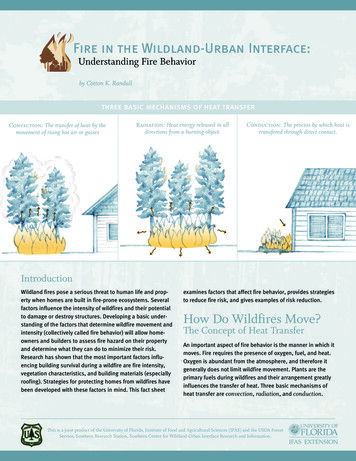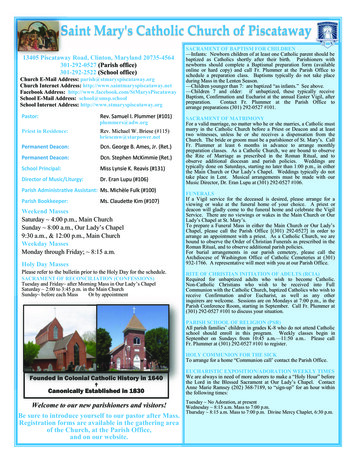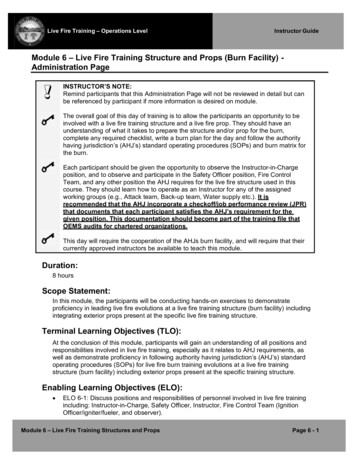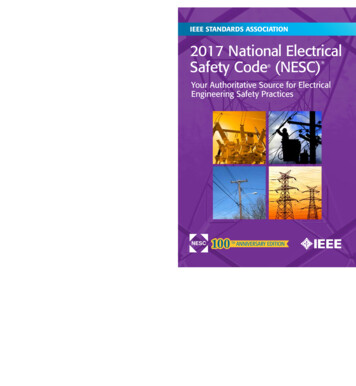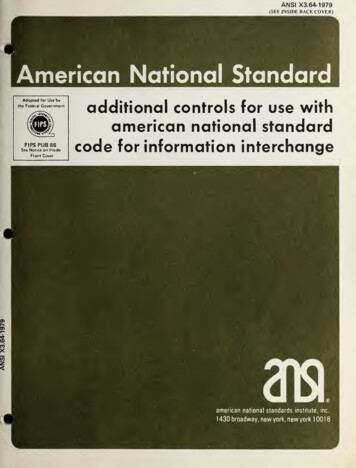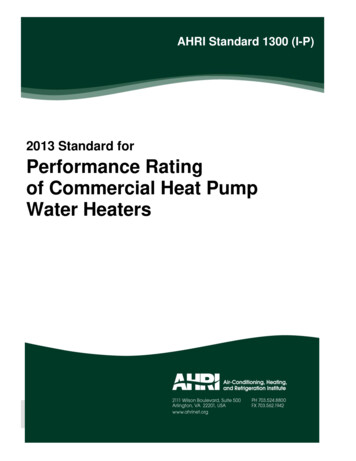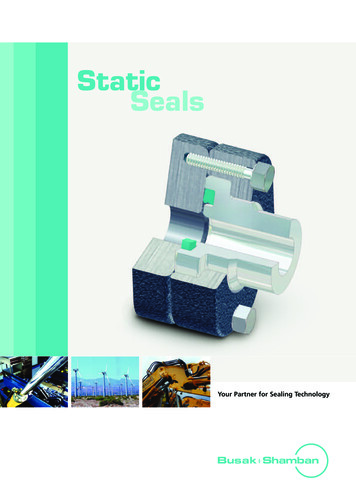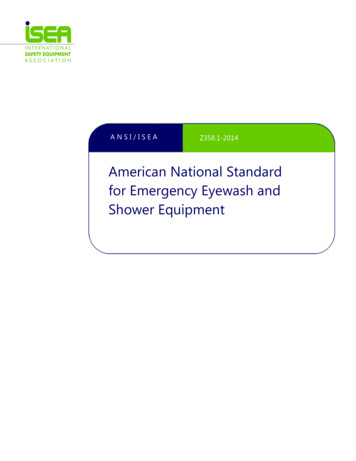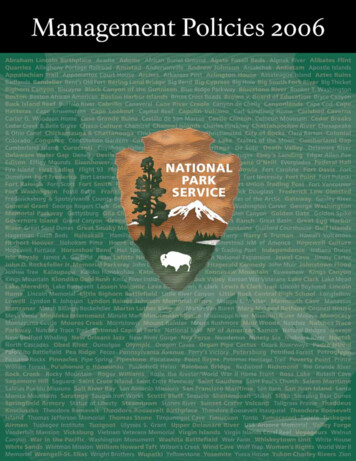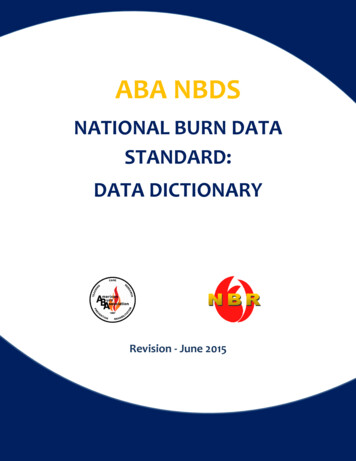
Transcription
ABA NBDSNATIONAL BURN DATASTANDARD:DATA DICTIONARYRevision - June 2015Section ANational Burn Data Standard Data ToolsPage 1 of 159
TABLE OF CONTENTSINTRODUCTION. 4NATIONAL BURN DATA STANDARD . 6DATASET PATIENT INCLUSION CRITERIA . 6NATIONAL BURN DATA STANDARD INCLUSION SCHEMA . 7NATIONAL BURN DATA STANDARD DATA TOOLS . 8COMMON NULL VALUES . 8DEMOGRAPHIC INFORMATION. 9PATIENT’S HOME ZIP OR POSTAL CODE . 10PATIENT’S HOME COUNTRY . 12PATIENT’S HOME STATE . 14PATIENT’S HOME COUNTY. 16PATIENT’S HOME CITY . 18ALTERNATE HOME RESIDENCE . 20DATE OF BIRTH . 22AGE . 24AGE UNITS . 26RACE . 28ETHNICITY . 30SEX . 32PATIENT’S OCCUPATION PRIMARY . 34PATIENT’S OCCUPATION SECONDARY . 36MARITAL STATUS . 38LIVING WITH AT TIME OF INJURY . 39LIVING SITUATION . 40INJURY INFORMATION . 42INJURY INCIDENT DATE . 43INJURY INCIDENT TIME . 45WORK-RELATED . 47INCIDENT LOCATION ZIP OR POSTALCODE . 49INCIDENT COUNTRY . 51INCIDENT STATE. 53INCIDENT COUNTY . 55INCIDENT CITY . 57ALCOHOL USE INDICATOR. 59DRUG USE INDICATOR . 61DRUG USE TEST RESULTS . 63CIRCUMSTANCES OF INJURY. 65REPORT OF PHYSICAL ABUSE . 67ETIOLOGY OF BURN INJURY . 68ICD-9 PRIMARY E-CODE . 70ICD-10 PRIMARY E-CODE . 72ICD-9 LOCATION E-CODE . 74ICD-10 LOCATION E-CODE . 76ICD-9 ADDITIONAL E-CODE . 78ICD-10 ADDITIONAL E-CODE . 80INJURY SEVERITY . 82NDTOTAL BURN SIZE (2 DEGREE) . 83RDTOTAL BURN SIZE (3 DEGREE) . 84NDBURN LOCATIONS 2 DEGREE . 85BURN LOCATIONS 3RD DEGREE. 87INHALATION INJURY . 89Section ANational Burn Data Standard Data ToolsPage 2 of 159
CARBOXYHEMOGLOBIN LEVEL . 90INITIAL GCS (TOTAL) . 91INITIAL ED / HOSPITAL TEMPERATURE . 92DIAGNOSES . 93DIAGNOSIS ICD-9 CODE . 95DIAGNOSIS ICD-10 CODE . 96CO-MORBID CONDITIONS . 97CONCOMITANT INJURY DIAGNOSES ICD-9 . 99CONCOMITANT INJURY DIAGNOSES ICD-10 . 101NON-BURN INJURY . 103BURN CENTER ADMISSION INFORMATION . 104ADMISSION DATE . 107ADMISSION TIME . 109ADMISSION TYPE . 111ADMISSION STATUS . 113ADMISSION SOURCE . 114ADMISSION CATEGORY. 115TRANSPORT MODE . 116HOSPITAL TRANSFER / REFERRAL. 119HOSPITAL PROCEDURE INFORMATION . 121HOSPITAL PROCEDURE START DATE . 122ICD-9 HOSPITAL PROCEDURES . 124ICD-10 HOSPITAL PROCEDURES . 126OUTCOME INFORMATION. 128HOSPITAL DISCHARGE DATE . 129TOTAL ICU LENGTH OF STAY . 131TOTAL VENTILATOR DAYS . 132HOSPITAL DISCHARGE DISPOSITION . 134CARE DIRECTIVES . 136HOSPITAL COMPLICATIONS . 137FINANCIAL DATA . 139MS-DRG CODE ICD 9 . 140MS-DRG CODE ICD 10 . 141PRIMARY METHOD OF PAYMENT. 142HOSPITAL CHARGES . 143RELATED ADMISSIONS. 144RELATED ADMISSIONS . 145APPENDICES . 146APPENDIX I: GLOSSARY OF TERMS . 147APPENDIX II: GLOSSARY OF TERMS . 150APPENDIX III: GLOSSARY OF TERMS . 156Section ANational Burn Data Standard Data ToolsPage 3 of 159
INTRODUCTIONOrganizations providing health care to the public maintain summary records or a registry of the patientsthey treat. These are helpful to the organization by documenting their experience and helping them plan for andadjust resource and personnel allocation. In addition, summary data can be used by the organization toexamine the outcomes of the care that they provided and to identify areas in which patient care practice mightbe modified to improve those outcomes. This effort is greatly enhanced if the organization can compare or‘benchmark’ its experience and outcomes with those of other similar organizations. Thus, regional, national,and even international patient registries have been developed.Burns comprise a unique subset of traumatic injuries. Burns are highly morbid with long-lastingsequelae and, in some cases, fatal. Burn care can be prolonged and costly. Burns are also much lesscommon than other kinds of injuries, so that it can be difficult within a single organization to develop expertise orto find efficiencies that can make the fiscal demands feasible to meet.Specialized Burn Centers have developed in certain hospitals throughout the world to address thespecific and specialized needs of people who sustain burn injuries. Burn centers are dedicated to caring forpatients with burns and other skin and soft tissue injuries and disorders. They also typically serve patients froma much wider region than the city in which the hospital is located. For these Burn Centers to compare or‘benchmark’ their experience and outcomes with other burn centers, they must be part of a broad, national orinternational burn registry.The burn community recognized this challenge with the formation of the National Burn InformationExchange (NBIE) at the University of Michigan in 1964. Individual hospitals that cared for burn patientssubmitted data to the NBIE, and summary reports were prepared. Although differences in outcomes betweencenters were observed, it was difficult to interpret them. The simple collating of individual hospital registries wasproblematic.Similar difficulties also had frustrated the efforts of the American College of Surgeons (ACS) and itsCommittee on Trauma (COT), when they tried to assemble a National Trauma Data Bank (NTDB) by combiningcontributions from individual hospital trauma registries. The data content and structure were so variable thatcomparison was almost impossible. Not only were there independent local clinical definitions andinterpretations of the variables at different trauma centers, but different software packages structured andconfigured the data elements differently. The solution was the development of a National Trauma DataStandard (NTDS). This served not only as the data dictionary for the NTDB, but also as a reference fordevelopers of trauma registry software, so that they could either use the same data structure in their programsas that described in the NTDS, or provide a mapping program that would translate the data in their registries intoa form compatible with the NTDS.The NBIE evolved over the years into the National Burn Repository (NBR). That database is nowmanaged by the American Burn Association (ABA). The ABA formed a Burn Registry Committee and an NBRCommittee in order to improve the quality of the data in the NBR, so that it is as accurate, valid, and reliable aspossible. An initial problem was the large amount of missing data elements in the database, and that hasimproved markedly. There remains substantial variability, however, in the consistency of the data as recordedand submitted by individual centers. In addition, there is considerable variability among Burn Centers in thedefinitions for several data elements that are critical for characterizing burn injury. This significantlycompromises the value of the data as a clinical, research, and benchmarking tool. The National Burn DataStandard (NBDS) is an attempt to bring uniformity to that process and further strengthen the National BurnRepository.The NBDS seeks to establish a national standard for the collection and exchange of burn data. It alsoserves to specify the operational definitions of the data elements for the NBR. It is our hope that regional andstate or provincial entities interested in burn patient data as well as commercial developers of registry softwarewill modify or extend their registries to adopt NBDS-based definitions. We also acknowledge that local and stateSection ANational Burn Data Standard Data ToolsPage 4 of 159
burn data sets may contain additional data points than those described here. It is important to note that the datain those registries can still be fully compliant with the NBDS via development of a mapping process.The data elements described in this document make up a set of data that captures the nature,treatment, and outcome of a specific burn injury in an individual patient at a specific institution. That collectionof data comprises a single record in a burn registry (or the NBR). For Burn registries of the past, thefundamental defining event for a record in a registry was admission to a health care facility, in particular a burncenter. In the past, most of the acute care for the injury occurred in that setting, so that it made sense that theorganizing event was admission to the hospital.However, contemporary burn care no longer fits that model as many patients have a portion or theentirety of their care outside of the hospital walls. Care that was once provided over a long hospital stay, is nowprovided in part as an outpatient with short periods of hospitalization for specific purposes. For example, somepatients may be discharged before wound closure and with some uncertainty about the potential forspontaneous closure. The NBDS attempts to account for these contemporary practices. It views a singlerecord as all the data relating to treatment for a given injury in an individual patient at a single center. The dataelements in this document are organized in accordance with that case definition. The first groups of variablesare those describing the injury and the patient, pages 11 - 105. These would not vary from one admission toanother. The variables that relate to a specific admission are listed on pages 106 – 141. Any subsequentadmission or re-admission to the same Burn Center for treatment of the same injury would be described bydifferent values of these same variables. This is a fundamental change in how the records in a given registry orthe NBR are organized. It is important to note this first version of the NBDS only captures inpatient admissionsand activities although we expect this too will appropriately evolve.We believe the NBDS may an important step in the continued maturation of the American BurnAssociation’s data collection efforts. We are extremely grateful for the contributions of the members of theBurn Registry and NBR Committees and to the unflagging dedication of the ABA Central Office staff to see thisproject to fruition. The ABA has enjoyed a long and productive relationship with the ACS and its Committee onTrauma (COT), and we gratefully acknowledge the help and advice of David B. Hoyt, MD FACS, ExecutiveDirector, and Howard Tanzman, Director of Information Technology, on the development of the NBDS. Finally,we thank John Kutcher, Julie Violante, and Lauren Stallings of Digital Innovation, Inc. for their technicalexpertise and guidance.Matthew B. Klein, MD, FACSPalmer Q. Bessey, MD, FACSEditorsSection ANational Burn Data Standard Data ToolsPage 5 of 159
NATIONAL BURN DATA STANDARDDATASET PATIENT INCLUSION CRITERIADEFINITION:To assure consistent data collection, the National Burn Data Standard should apply to allpatients who are cared for in a burn care facility for treatment of a burn or some other injuryor acute condition that affects the integrity of the skin or for an injury related to a fire.Such conditions would usually include at least one of the following diagnosis codes.The International Classification of Diseases, Ninth Revision, Clinical Modification (ICD9-CM)is the current reference for diagnosis coding. Patients to whom the National Burn DataStandard applies most commonly would be assigned one or more of the following ICD9codes:940.0 – 949.5AND / OR986 AND / OR 987.9OR910.0 – 929.9OR695.13 – 695.15 AND 695.50 – 695.59OR728.86 OR 286.6Some patients may have other ICD9 codes that could be associated with an acute skin injuryand be treated in a burn care facility. The National Burn Data Standard should apply to themalso.In October 2015, it is anticipated that the accepted reference for diagnosis codes will beICD10. Comparable codes in that reference would include:T26 – T30ORAND / ORT58 AND / OR T59S00, S20, S40, S50, S60, S80, S70, S90,S07, S17, S28, S38, S47, S57, S67, S77, S87, or S97ORL51, L12ORM72.6 OR D65The patients MUST also meet one of the following in addition to the diagnosis codesabove:Hospital admission as defined by your burn or trauma registry inclusion criteriaORPatient transfer via EMS transport (including air ambulance) from one hospital toanother hospitalORDeath resulting from the burn injury (independent of hospital admission or hospitaltransfer status)Section ANational Burn Data Standard Data ToolsPage 6 of 159
NATIONAL BURN DATA STANDARD INCLUSION SCHEMADid the patient sustainone or more injuriesaffecting the skin?Did the patient inhalesmoke or some otherproduct of combustion?NoNoYesYesWas thethe patientpatient treatedtreated inin youraWasBurnCareCareFacility?Facility?BurnNoYesDid the injury orcondition result indeath?ORWas the patienttransferred to (or from)your hospital viaanother hospital usingEMS or air ambulance?ORWas the patientconsidered anadmission based onyour burn or traumaregistry inclusioncriteria?NoFor ALL threeYesNational Burn Data StandardAPPLIES to this PatientSection ANational Burn Data Standard Data ToolsNational Burn Data StandardDOES NOT APPLY to this PatientPage 7 of 159
NATIONAL BURN DATA STANDARD DATA TOOLSCOMMON NULL VALUESData Format [combo] single-choiceNational ElementDefinitionThese values are to be used with each of the National Burn Data Standard Data Elements described in thisdocument which have been defined to accept the Null Values.Field Values1 Not Applicable2 Not Known/Not RecordedAdditional Information For any collection of data to be of value and reliably represent what was intended, a strong commitmentmust be made to ensure the correct documentation of incomplete data. When data elements associatedwith the National Burn Data Standard are to be electronically stored in a database or moved from onedatabase to another using XML, the indicated null values should be applied. Not Applicable: This null value code applies if, at the time of patient care documentation, the informationrequested was “Not Applicable” to the patient, the hospitalization or the patient care event. For example,variables documenting EMS care would be “Not Applicable” if a patient self-transports to the hospital. Not Known/Not Recorded: This null value applies if, at the time of patient care documentation, informationwas “Not Known” (to the patient, family, health care provider) or no value for the element was recorded forthe patient. This documents that there was an attempt to obtain information but it was unknown by allparties or the information was missing at the time of documentation. For example, injury date and time maybe documented in the hospital patient care report as “Unknown”. Another example, Not Known/NotRecorded should also be coded when documentation was expected, but none was provided (i.e., no EMSrun sheet in the hospital record for patient transported by EMS).Section ANational Burn Data Standard Data ToolsPage 8 of 159
DEMOGRAPHIC INFORMATIONSection BDemographic InformationPage 9 of 159
PATIENT’S HOME ZIP OR POSTAL CODEData Format [text]National ElementDefinitionThe patient’s home ZIP or Postal code of primary residence.XSD Element / Domain (Simple Type) HomeZipField Values Relevant value for data elementAdditional Information Can be stored as an alpha and/or numeric digit code, to include spacing or dashes as allowablecharacters (accepts both U.S. and International zip and postal codes).May require adherence to HIPAA regulations.If zip code is "Not Applicable", complete variable: Alternate Home Residence.If zip code is "Not Recorded/Not Known", complete variables: Patient's Home Country; Patient's HomeState; Patient's Home County and; Patient's Home City.Data Source Hierarchy1. Billing Sheet / Medical Records Coding Summary Sheet2. ED Admission Form3. EMS Run Sheet4. Triage Form / Trauma Flow Sheet5. ED Nurses Notes6. Patient Interview / ReportUsesAllows data to be sorted based upon the geographic location of the patient’s home.Data Collection EMS or hospital records or electronically through linkage with the EMS/medical record.Other Associated Elements Common Null Values Patient’s Home Country Patient’s Home State Patient’s Home County Patient’s Home City Alternate Home ResidenceSection BDemographic InformationPage 10 of 159
ASSOCIATED EDIT CHECKSRule IDLevel Message10.01.011Invalid value10.01.024Blank, required field10.01.035Not Applicable, complete variable: Alternate Home Residence10.01.045Not Known/Not Recorded, complete variables: Patient's Home Country,Patient's Home State, Patient's Home County and Patient's Home CitySection BDemographic InformationPage 11 of 159
PATIENT’S HOME COUNTRYData Format [combo] single-choiceNational ElementDefinitionThe country where the patient resides.XSD Element / Domain (Simple Type) HomeCountryField Values Relevant value for data element (two digit alpha country code). Pick List from ABA TRACS.Additional Information Only completed when ZIP code is "Not Recorded/Not Known”.Values are two character fields representing a country (e.g., US).Data Source Hierarchy1. Billing Sheet / Medical Records Coding Summary Sheet2. ED Admission Form3. EMS Run Sheet4. Triage Form / Trauma Flow Sheet5. ED Nurses Notes6. Patient ReportUses Allows data to be sorted based upon the geographic location of the patient’s home.Data Collection EMS or hospital records or electronically through linkage with the EMS/medical record.Other Associated Elements Common Null Values Patient’s Home State Patient’s Home County Patient’s Home City Alternate Home ResidenceSection BDemographic InformationPage 12 of 159
ASSOCIATED EDIT CHECKSRule IDLevel Message10.02.011Invalid value10.02.024Blank, required to complete when Patient's Home Zip Code is NotKnown/Not Recorded10.02.035Blank, required to complete variables: Patients Home Zip Code orAlternate Home ResidenceSection BDemographic InformationPage 13 of 159
PATIENT’S HOME STATEData Format [combo] single-choiceNational ElementDefinitionThe state (territory, province, or District of Columbia) where the patient resides.XSD Element / Domain (Simple Type) HomeStateField Values Relevant value for data elementAdditional Information Only completed when ZIP code is "Not Recorded/Not Known".Used to calculate FIPS code.Data Source Hierarchy1. ED Admission Form2. Billing Sheet / Medical Records Coding Summary Sheet3. EMS Run Sheet4. Triage Form / Trauma Flow Sheet5. ED Nurses Notes6. Patient ReportUses Allows data to be sorted based upon the geographic location of the patient’s home.Data Collection EMS or hospital records or electronically through linkage with the EMS/medical record.Other Associated Elements Common Null Values Patient’s Home Country Patient’s Home County Patient’s Home City Alternate Home ResidenceSection BDemographic InformationPage 14 of 159
ASSOCIATED EDIT CHECKSRule IDLevel Message10.03.011Invalid value10.03.024Blank, required to complete when Patient's Home Zip Code is NotKnown/Not Recorded10.03.035Blank, required to complete variables: Patients Home Zip Code orAlternate Home ResidenceSection BDemographic InformationPage 15 of 159
PATIENT’S HOME COUNTYData Format [combo] single-choiceNational ElementDefinitionThe patient’s county (or parish) of residence.XSD Element / Domain (Simple Type) HomeCountyRequired in XSD YesField Values Relevant value for data elementAdditional Information Only completed when ZIP code is "Not Recorded/Not Known".Data Source Hierarchy1. Billing Sheet / Medical Records Coding Summary Sheet2. ED Admission Form3. EMS Run Sheet4. Triage Form / Trauma Flow Sheet5. ED Nurses Notes6. Patient ReportUses Allows data to be sorted based upon the geographic location of the patient’s home.Data Collection EMS or hospital records or electronically through linkage with the EMS/medical record.Other Associated Elements Common Null Values Patient’s Home Country Patient’s Home State Patient’s
DATA DICTIONARY Revision - June 2015 . . Some patients may have other ICD9 codes that could be associated with an acute skin injury and be treated in a burn care facility. The National Burn Data Standard should apply to them also. In October 2015, it is anticipated th

